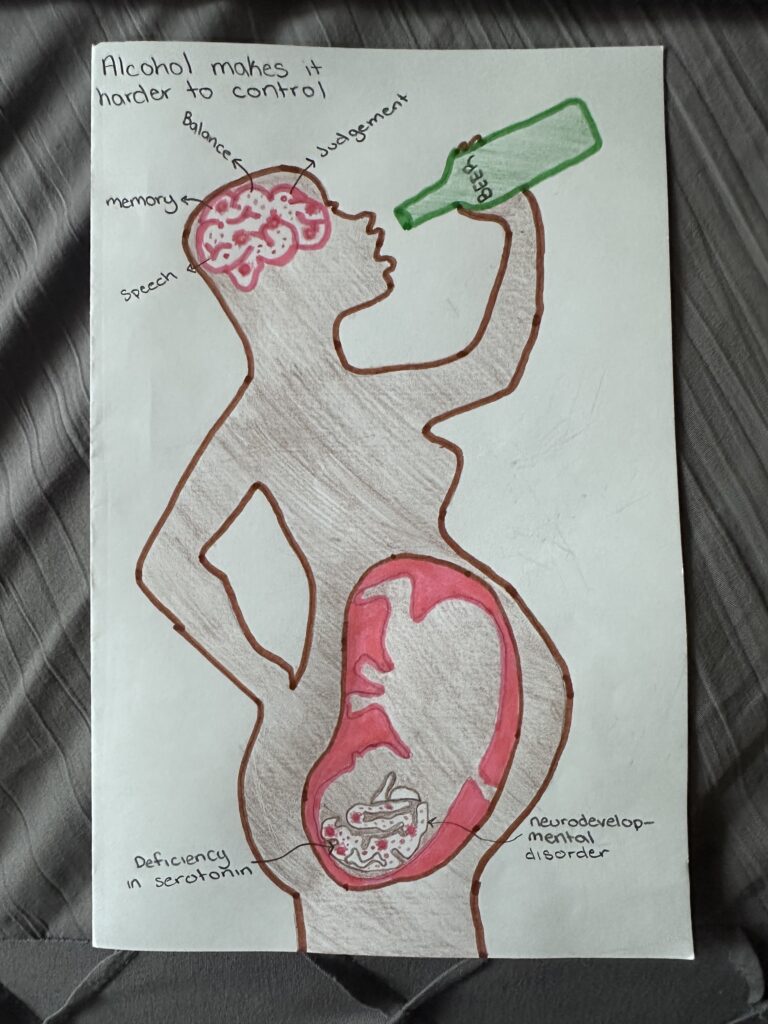
Scientists have tried for quite some time to figure out how alcohol affects the brain and change behavior. This paper will identify various components and key structures of the nervous system. It will also explain the effects of alcohol on neurotransmitters and how they are affected for long and short term. Lastly, it will discuss how alcohol “cause neurodevelopmental disorders in the fetus, or partial syndromes primarily affecting the central nervous system” (Sari et al., 2010).
The nervous system is composed of two components, the peripheral nervous system (PNS) and the central nervous system (CNS) (Thau et al., 2022). The central nervous system consists of the spinal cord and brain. The peripheral nervous system consists of everything else. Each component of the nervous system has its own structure. In the peripheral nervous system, ganglia and nerves are distinct structures. The central nervous system structure is not obvious and prepared tissue has to be examined under the microscope. Both of the components have nervous tissue present in them called neurons and glial cells (Betts et al., 2022). The glial has a lot of tissue that supports the activities of neurons. The neurons are the communicative function within the nervous system and between the two is more important functionally (Betts et al., 2022). The neurons also have a structure. They have a soma, which is also called a cell body. The cell body has a cell extension called a process. One process that is important is called an axon. Axons connect the target to neurons. Another process that branches off the cell extension is called dendrite. The inputs that are received from the neurons are the responsibility of dendrites. The nervous system also has two regions within its structure and that is gray matter and white matter. Gray matter is the region that has numerous dendrites and cell bodies and white matter is the region that has many axons.
There is evidence that suggests the effects of alcohol on neurotransmitters. Evidence proposed multiple neurotransmitter systems are affected by alcohol through its interaction. The interaction disrupts how the inhibitory and excitatory neurotransmitters are balanced. If there are short term exposures to alcohol, the balance is tilted to favor the influences of inhibitory. If alcohol is consumed for a short term, it depresses the brain function. It acts as a depressant by inhibitory transmissions being increased and excitatory neurotransmission being decreased or a combination of both (Valenzuela, 1997). If there is long-term exposure to alcohol, the brain tries to counterbalance the equilibrium. Long-term use of alcohol also increases neurotransmitter system changes that causes the behavior of seeking to use and crave alcohol. If the use of alcohol is stopped or reduced, the compensatory changes are not conflicting because of the use of alcohol and this causes the excitation of neurotransmitters and alcohol withdrawal is developing (Valenzuela, 1997).
If alcohol is used during pregnancy, it can cause partial syndromes that affect the central nervous system and a neurodevelopmental disorder in the fetus. There has been experiments and clinical evidence that show the exposure to alcohol can cause different disruptions in the migration and proliferation of neuronal and glial cells during the fetal development stages (Sari et al., 2010). A study done using rats and mice showed the growth of the central nervous system was hindered. “The neurotoxic effects of ethanol may also cause disruptions in the development of neurotransmitter systems such as serotonin and dopamine” (Sair et al., 2010). Serotonin and levels are lowered during prenatal alcohol exposure in rats at the stage of mid-gestation. In a fetus, serotonin and dopamine levels are lowered during prenatal alcohol exposure while y-aminobutyric acid (GABA) levels are increased.
The bottom line is that alcohol has many effects on neurotransmitters. Drinking over time can cause progressive changes in the function and structure of the brain. It is not fully understood if the brain can go back to normal after being sober for a long period of time. There are a growing number of studies that indicate that there can be some changes in behavior, feeling and thinking can improve. Children that had fetal alcohol exposure can have cognitive, developmental and behavioral problems anytime during childhood, but with a lot of care and assistance they can still be successful.
References
Betts, J., Young, K., Wise, J., Johnson, E., Poe, B., Kruse, D., Korol, O., Johnson, J., Womble, M. & DeSaix, P. (2022). Anatomy and Physiology 2e.
Sari, Y., Hammad, L., Saleh, M., Rebec, G., & Mechret, Y. (2010). Alteration of selective neurotransmitters in fetal brains of prenatally alcohol treated C57BL/6 mice: quantitative analysis using liquid chromatography/tandem mass spectrometry. National Library of Medicine. doi:10.1016/j.ijdevneu.2010.01.004.
Thau, L., Reddy, V. & Singh, P. (2022). Anatomy, Central Nervous System. National Library of Medicine. Retrieved from https://www.ncbi.nlm.nih.gov/books/NBK542179/.
Valenzuela, C. (1997). Alcohol and Neurotransmitter Interactions. Alcohol Health Res World. 21(2), 144-148.
